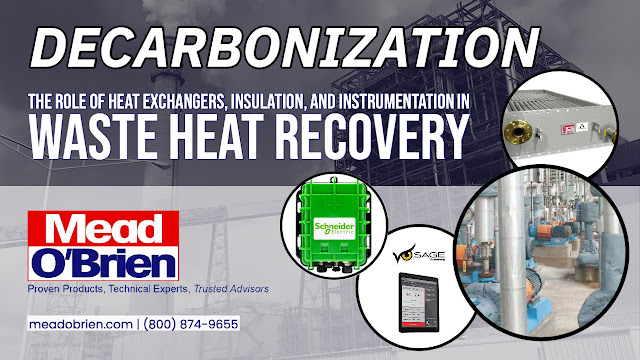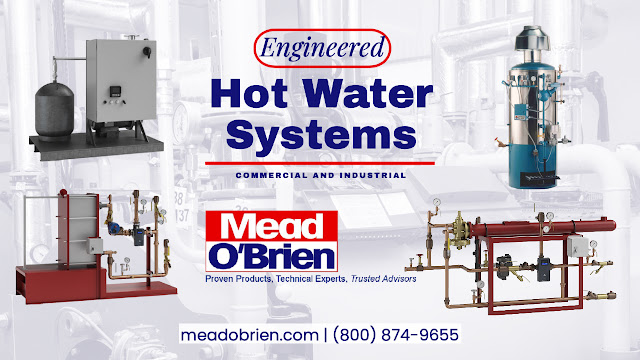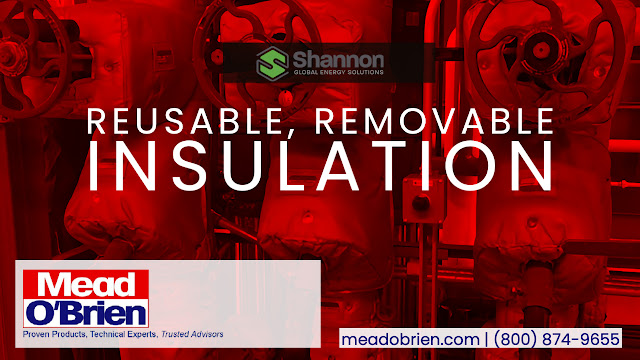Providing problem solving and educational information for topics related to industrial steam, hot water systems, industrial valves, valve automation, HVAC, and process automation. Have a question? Give us a call at (800) 892-2769 | www.meadobrien.com
The Role of Heat Exchangers, Insulation, and Instrumentation in Heat Recovery and Decarbonization Efforts
Gas Powered Actuators for the Oil and Gas Industry
The gas-powered scotch yoke actuator is a mechanical device designed to convert linear motion into rotary motion, primarily used for valve actuation in the oil and gas industry and other industrial applications requiring precision control of fluid flow. This actuator is particularly advantageous for heavy-duty and high-torque applications, offering reliable and efficient operation with minimal maintenance. Here's a detailed overview of how it operates and its primary application:
Operation:
- Gas supply: The gas-powered scotch yoke actuator uses pressurized gas as the driving force, which, depending on the specific application and site requirements, the gas source is a natural gas pipeline, an onsite compressor, or bottled gas.
- Pneumatic cylinder: The gas enters the pneumatic cylinder, which is the core component of the actuator. The cylinder contains a piston that moves linearly when pressurized gas is applied.
- Scotch yoke mechanism: The linear motion of the piston is converted into rotary motion using the scotch yoke mechanism. The scotch yoke consists of a yoke (a slotted, U-shaped component) attached to the piston rod and a pin mounted on the rotating output shaft. The yoke slides along the pin as the piston moves linearly, causing the output shaft to rotate.
- Output shaft: The output shaft's rotation is transferred to the valve stem, causing the valve to open or close, depending on the direction of the rotation. The shaft is connected to the valve using a coupling, which ensures proper alignment and torque transmission.
- Spring return mechanism: Some gas-powered scotch yoke actuators have a spring return mechanism, which enables the valve to return to a predetermined fail-safe position in the event of a loss of gas supply or system failure.
Primary application: The primary application of the gas-powered Scotch yoke actuator is in the oil and gas industry, where it controls various types of valves, such as ball valves, butterfly valves, and plug valves. These valves are essential for regulating the flow of oil, gas, or other fluids in pipelines, processing plants, and other facilities.
The actuator's high torque capabilities make it suitable for heavy-duty applications, such as large-diameter or high-pressure valves. Additionally, the gas-powered design offers several advantages over electric or hydraulic actuators, including lower operating costs, reduced environmental impact, and compatibility with remote or hazardous locations where electricity or hydraulic power may not be readily available.
Limitorque has established a dominant position in the gas-powered scotch yoke actuator market, owing to its reputation for delivering high-quality, reliable, and efficient products. Their actuators are known for their durability and low maintenance requirements, making them a preferred choice for heavy-duty applications in the oil and gas industry. The company's commitment to continuous innovation and its extensive experience in the field has allowed them to develop customized solutions to address the unique challenges faced by its customers. Furthermore, Limitorque's strong global presence and extensive support network ensure they provide exceptional after-sales service, reinforcing their position as a trusted leader in the market.
Mead O'Brien
(800) 892-2769
Decarbonization of Industrial Facilities and the Crucial Role of Process Instrumentation and Valves
In recent years, concerns about climate change have spurred a global push towards decarbonization, the reduction of greenhouse gas emissions, particularly carbon dioxide, from human activities. This movement involves transforming various sectors, including industrial facilities that account for a significant portion of global emissions. A critical aspect of this decarbonization drive is the adoption of advanced process instrumentation and valves, which are pivotal in improving efficiency, reducing energy consumption, and minimizing emissions. This article will explore the importance of process instrumentation and valves in decarbonizing industrial facilities and discuss the latest technological advancements.
The Importance of Process Instrumentation and Valves in Decarbonization
Enhancing Energy Efficiency
Process instrumentation and valves are critical components of industrial control systems that regulate and monitor processes in facilities such as power plants, refineries, and manufacturing plants. By providing accurate and real-time data on parameters such as pressure, temperature, flow, and level, these instruments enable operators to optimize processes and reduce energy consumption. Efficient and precise valve control also ensures energy use applies when and where needed, preventing wastage and reducing overall energy demand.
Reducing Greenhouse Gas Emissions
Advanced process instrumentation and valves help reduce greenhouse gas emissions by identifying inefficiencies and leaks in industrial processes. For instance, smart valves with built-in sensors can detect gas leaks, enabling operators to address the issue promptly and minimize emissions. Moreover, advanced control systems can optimize combustion processes in power plants and other facilities, reducing the amount of carbon dioxide and other greenhouse gases released into the atmosphere.
Facilitating the Integration of Renewable Energy
As industries transition towards renewable energy sources, process instrumentation, and valves play a crucial role in integrating these technologies into existing infrastructure. Advanced control systems can effectively manage the variable nature of renewable energy sources, such as solar and wind, ensuring a stable and reliable power supply. Additionally, smart valves can help balance the flow of energy between different sources, optimizing the system's overall efficiency.
Technological Advancements in Process Instrumentation and Valves
Digitalization and the Industrial Internet of Things (IIoT)
Digitalization and the Industrial Internet of Things (IIoT) are revolutionizing process instrumentation and valve technology. Integrating sensors, communication networks, and data analytics allows for real-time monitoring, predictive maintenance, and remote control of industrial processes. This interconnected system enhances efficiency, minimizes downtime, and reduces energy consumption, contributing significantly to decarbonization efforts.
Advanced Materials and 3D Printing
The development of advanced materials and the adoption of 3D printing technology in producing process instruments and valves have significantly improved performance, durability, and efficiency. For example, advanced alloys and ceramics can withstand extreme temperatures and pressures, reducing energy losses and improving the overall efficiency of industrial processes.
Machine Learning and Artificial Intelligence (AI)
Machine learning and artificial intelligence (AI) are increasingly utilized in process instrumentation and valve technology. These advanced algorithms can analyze data from sensors and other sources to predict equipment failures, optimize processes, and recommend maintenance activities. AI-driven process instrumentation and valves play a crucial role in decarbonizing industrial facilities by enhancing efficiency, minimizing downtime, and reducing energy consumption.
Decarbonizing industrial facilities is essential to mitigate climate change and achieve a sustainable future. Process instrumentation and valves play a vital role in this endeavor by enhancing energy efficiency, reducing greenhouse gas emissions, and facilitating the integration of renewable energy sources. As technology advances, adopting digitalization, advanced materials, and AI-driven solutions will further improve industrial processes' performance and environmental impact, accelerating the global shift towards decarbonization.
Mead O'Brien
(800) 874-9655
Industrial and Commercial Hot Water System Design, Fabrication, Installation, and Support
Choosing the right company specializing in engineering and integration services to design and install industrial and commercial hot water systems can significantly value your organization. You can realize this value through several key aspects, including expertise, cost savings, efficiency, safety, and scalability.
- Expertise: A specialized company has extensive knowledge in designing, installing, and maintaining large-scale hot water systems. Their engineers and technicians are highly skilled in selecting the right components, such as boilers, pumps, valves, and control instrumentation, ensuring a high-quality and reliable system that meets the specific requirements of your business.
- Cost savings: By partnering with an experienced company, you can save costs in several ways. First, you avoid making expensive mistakes during the design and installation phases. Second, the company's knowledge of the latest technologies and best practices allows them to design energy-efficient systems, reducing operational costs. Third, they can also help you take advantage of available incentives and rebates from utility companies and government programs.
- Efficiency: A well-designed hot water system ensures optimal performance and efficiency. By working with a specialized company, you benefit from their expertise in selecting and configuring the right components to achieve the highest possible efficiency, reducing energy consumption, lowering greenhouse gas emissions, and minimizing your environmental impact.
- Safety: Industrial and commercial hot water systems involve high pressures, temperatures, and potential hazards. By partnering with a company experienced in these systems, you ensure adherence to all safety protocols and regulations, which reduces the risk of accidents and liabilities.
- Scalability: As your business grows, your hot water system may need to be expanded or upgraded. An experienced company can design your system with scalability in mind, making it easier and more cost-effective to add capacity or make modifications in the future.
- Compliance: A specialized company knows the codes, standards, and regulations governing large industrial and commercial hot water systems, ensuring that your system is designed and installed in compliance with all applicable requirements, avoiding potential fines and penalties.
- Support and maintenance: A reliable partner can provide ongoing support, including regular maintenance, troubleshooting, and repairs, ensuring your hot water system remains in optimal condition throughout its lifecycle, reduces downtime, and extends the life of your investment.
Mead O'Brien offers engineering and integration services for industrial and commercial hot water systems providing expertise, cost savings, efficiency, safety, scalability, compliance, and ongoing support. Partnering with Mead O'Brien leads to a more reliable, efficient, and cost-effective hot water system for your organization, while minimizing risks and ensuring compliance with relevant regulations.
For more information, contact Mead O'Brien. Call (800) 874-9655 or visit https://meadobrien.com.
The Role of Industrial Diaphragm Seals
- Protection against corrosive media: Diaphragm seals isolate the gauge from corrosive liquids and gases, preventing damage to the indicator and ensuring accurate readings.
- High-temperature resistance: Diaphragm seals use materials that can withstand high temperatures, such as PTFE and Monel, allowing the application of the gauge in high-temperature applications without affecting accuracy.
- Vibration resistance: In high-vibration applications, diaphragm seals reduce the vibration transfer to the gauge, reducing the risk of damage and ensuring accuracy.
- Media compatibility: The diaphragm material can be selected based on compatibility with the process media, ensuring accurate readings and preventing damage to the gauge.
- Longer service life: A diaphragm seal with a pressure gauge in corrosive, high-temperature, and high-vibration applications can extend the service life of the pressure gauge, reducing the need for maintenance and replacements.
Benefits of Removable Reusable Insulation
- Acoustic Blankets & Shields
- Acoustic Blankets For Fan And Blower Housings
- Hydrophobic Insulation Blankets
- Safety Fire Blankets
- Safety Rain Shield Protective Enclosures
- Safety Spray Shield
- Safety Throw Blanket
- Thermal Blankets
- Improved energy efficiency: Blanket insulation helps to keep heat inside the facility during the winter and outside during the summer, which can significantly reduce the amount of energy needed to heat or cool the building.
- Lower costs: Reusable blanket insulation is a cost-effective solution for insulation because it can be used multiple times. This reduces the cost of insulation over the life of the building.
- Easy installation: Blanket insulation is simple to install and can be cut to fit any shape or size, making it easy to use in a variety of industrial settings.
- Durable: Reusable blanket insulation is made of heavy-duty materials that can withstand the wear and tear of an industrial environment.
- Safety: Insulation blanket can reduce the hazards of hot surfaces, electrical and fire hazards.






